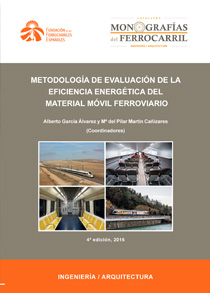
Categories
Publications
Methodology for evaluating the energy efficiency of railway rolling stock

In 2008 Instituto para la Diversificación y Ahorro de Energía (IDAE) and Fundación de los Ferrocarriles Españoles (FFE) signed a collaboration agreement which had the aim of defining the tasks to be performed in order to develop a methodology that allows rail transport operators and public authorities bidding public services to select the most energy efficient trains.
As a result of this agreement a work group on energy labelling in rail transport, whose management was assumed by FFE, was created. This document describes the work carried out and the results obtained within the framework of this agreement, which have been adapted to the latest technical recommendations. In it there is a definition of a homogeneous method to attribute to each train, in one or in several types of services and infrastructures, their energy consumptions and associated CO2 emissions.
With this tool, designers and rolling stock manufacturers will have an incentive to reduce consumption and therefore reach a competitive position in the market. They will also be able to improve the image of their products to the society and the buyers, as they will be able to communicate the improvements achieved in this field in an accurate way.
Publication index
- INTRODUCTION
- Background
- IDAE-FFE agreement
- Results of the work
- Scope
- Aim
- Organisation of the study and methodology
- GENERAL ASPECTS ABOUT EVALUATION AND STANDARDISATION OF ENERGY CONSUMPTION AND EMISSIONS IN TRAINS
- Considerations regarding the consumption indicator
- Types of indicators
- Influence of the types of services and infrastructures on the consumption
- THEORETICAL ESTIMATE OF THE CONSUMPTION OF A TRAIN IN A STANDARD SERVICE
- The model
- Design parameters of the train that have an influence on energy consumption
- Estimate of the energy consumed for train movement
- Losses in the traction chain
- Estimate of the energy consumed for auxiliary services
- Estimate and effect of the electric energy regenerated by the regenerative brake
- Estimate of the primary energy and emissions
- ECONOMIC ASSESSMENT OF THE CONSUMPTION
- Specifications
- Necessity to know the economic value of the energy consumed in the life cycle
- Method to estimate the cost of the energy consumed
- SUPPLEMENT
- BIBLIOGRAPHY
Download book (pdf - free) »
Purchase printed edition »


